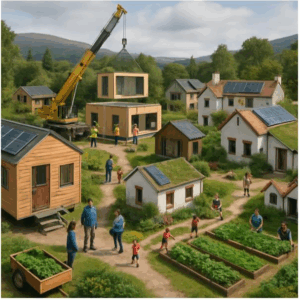Scotland’s commitment to achieving net-zero emissions by 2045 places the country’s aging housing stock at the center of its climate strategy. With approximately 80-85% of the buildings that will exist in 2045 already constructed, the challenge of retrofitting existing homes for energy efficiency represents one of the most significant undertakings in Scotland’s environmental and housing policy [2]. The scale of this challenge is matched only by its importance, as residential buildings account for a substantial portion of Scotland’s carbon emissions and energy consumption.
The current state of Scotland’s housing stock reveals both progress and persistent challenges in energy efficiency. According to the 2023 Scottish House Condition Survey, the mean energy efficiency rating of Scottish homes stands at 67.7 SAP points, with a
median of 69 points [2]. While this represents improvement over previous years, it falls short of the standards required to meet climate targets and ensure affordable warmth for all residents.
Insulation levels across Scotland’s housing stock show significant variation and highlight areas requiring urgent attention. Loft insulation has seen substantial improvement, with 96% of applicable dwellings now having 100mm or more of insulation, representing a remarkable increase from just 70% in 2003/04 [2]. However, only 29% of lofts meet the higher standard of 300mm or more insulation, indicating substantial room for improvement in achieving optimal energy efficiency.
The picture for wall insulation is more concerning, particularly for solid wall properties that make up a significant portion of Scotland’s traditional housing stock. While 71% of applicable dwellings have cavity wall insulation, only 20% of solid wall dwellings have external or internal wall insulation [2]. This disparity is particularly problematic given that many of Scotland’s most characterful and historically significant buildings feature solid wall construction, creating a tension between heritage preservation and energy efficiency requirements.
The energy efficiency gap between housing sectors reveals important policy implications. Social sector housing consistently outperforms private sector housing across multiple measures, with 69% of social homes having wall insulation compared to 55% in the private sector, and 77% having adequate loft insulation compared to 65% in the private sector [2]. This disparity reflects both the greater resources available to social landlords for improvement works and the regulatory requirements that govern social housing standards.
Scotland’s retrofitting challenge is complicated by the diversity of its housing stock. Traditional Scottish tenements, with their solid stone walls and distinctive architectural features, require different approaches than modern cavity wall constructions. Rural properties, often older and more exposed to harsh weather conditions, face unique challenges in achieving energy efficiency while maintaining their character and structural integrity.
The economic case for large-scale retrofitting extends beyond environmental considerations to encompass fuel poverty reduction, health improvements, and economic development opportunities. Fuel poverty affects approximately 25% of Scottish households, with inadequate insulation and inefficient heating systems contributing significantly to this problem [3]. Comprehensive retrofitting programs can simultaneously address climate goals and social justice concerns by reducing energy bills for vulnerable households.
The health benefits of improved housing energy efficiency are substantial and well-documented. Cold, damp homes contribute to respiratory problems, cardiovascular disease, and mental health issues, particularly among children and elderly residents. The NHS Scotland estimates that poor housing conditions cost the health service hundreds of millions of pounds annually in treatment costs that could be prevented through improved housing standards [4].
Successful retrofitting of Scotland’s housing stock requires a coordinated approach that addresses technical, financial, and regulatory barriers. The technical challenges are significant, particularly for older buildings where standard retrofitting approaches may not be suitable. Traditional Scottish buildings often require specialized knowledge and materials to ensure that energy efficiency improvements do not compromise structural integrity or create moisture problems.
The Scottish Government’s Area-Based Schemes (ABS) represent an important model for coordinated retrofitting efforts. These programs target specific geographic areas for comprehensive energy efficiency improvements, allowing for economies of scale and coordinated approaches that can address entire neighborhoods simultaneously. The success of schemes in areas like Musselburgh and Kirkcaldy demonstrates the potential for area-based approaches to deliver significant improvements while building local capacity and expertise.
Financial barriers remain one of the most significant obstacles to widespread retrofitting. While various grant schemes exist, including the Warmer Homes Scotland program and local authority initiatives, the upfront costs of comprehensive retrofitting can be prohibitive for many homeowners. Innovative financing mechanisms, such as on-bill financing, green mortgages, and property-linked loans, offer potential solutions that spread costs over time while ensuring that energy savings help offset repayment obligations.
The role of social landlords in driving retrofitting innovation cannot be overstated. Housing associations and local authorities manage substantial housing portfolios that provide opportunities for large-scale retrofitting programs. The Scottish Federation of Housing Associations has committed to achieving net-zero emissions across the social housing sector, with many individual associations developing ambitious retrofitting programs that serve as models for broader application.
Private sector engagement is crucial for achieving the scale of retrofitting required. The majority of Scotland’s housing stock is privately owned, making homeowner participation essential for meeting national climate targets. This requires not only financial support but also education, advice, and quality assurance to ensure that retrofitting work meets appropriate standards and delivers expected benefits.
The supply chain for retrofitting services needs significant development to meet the scale of demand that comprehensive programs would generate. Training programs for installers, quality assurance systems, and coordination mechanisms are all necessary to ensure that retrofitting work is completed to high standards. The establishment of retrofit coordinators, professionals who can assess properties and coordinate multiple improvement measures, represents an important step toward professionalizing the retrofitting sector.
Innovation in retrofitting technologies and approaches offers opportunities to improve effectiveness while reducing costs. Heat pump technology, smart heating controls, and advanced insulation materials all have roles to play in improving the energy efficiency of existing homes. However, these technologies must be adapted to the specific characteristics of Scottish housing stock and climate conditions.
The integration of renewable energy generation with retrofitting programs can maximize the environmental and economic benefits of improvement works. Solar panels, small-scale wind generation, and community energy systems can complement energy efficiency measures to create homes that not only use less energy but also generate clean electricity.
Regulatory frameworks need updating to support ambitious retrofitting goals while protecting homeowners and tenants. Energy efficiency standards for rental properties, disclosure requirements for property sales, and building standards for renovation work all influence the pace and quality of retrofitting activity. The Scottish Government’s consultation on energy efficiency standards for private rented properties represents an important step toward creating regulatory drivers for improvement.
The retrofitting of Scotland’s housing stock represents both a massive challenge and an unprecedented opportunity. Success will require sustained political commitment, adequate funding, technical innovation, and broad public engagement. The benefits extend far beyond carbon emission reductions to encompass improved health outcomes, reduced fuel poverty, enhanced property values, and economic development opportunities in the green economy.
The path forward requires recognition that retrofitting is not a one-size-fits-all solution but rather a complex undertaking that must be tailored to the diverse characteristics of Scotland’s housing stock. By combining area-based approaches, innovative financing, technical expertise, and regulatory support, Scotland can transform its aging housing stock into a model of energy efficiency that supports both climate goals and improved quality of life for all residents.






